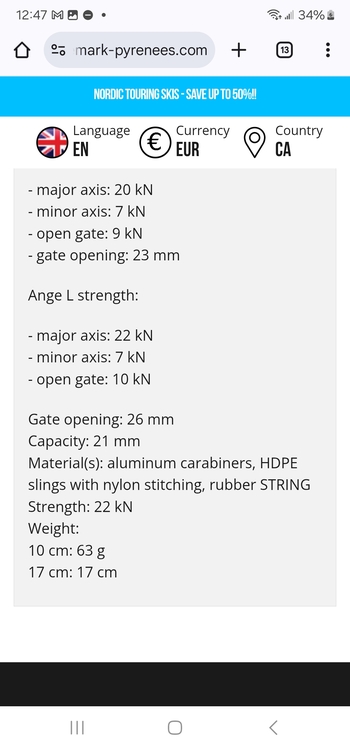Waterproofness of ange finesse dogbones
|
|
I'm looking for some dogbones for ice and alpine. Was looking into the finesse and they are HDPE with nylon stitching. Woild these be as waterproof as dyneema? Dyneema seems much lighter too but find it hard to grab Thanks |
|
|
"HDPE" seems to stand for "High Density Polyethylene," essentially the same material as Dyneema without the patent. There's been a struggle over what to call generic Dyneema: "UHMPWE;" "High-Modulus;" "HMP," and then there's trade names for it as well: Nexsteel, Acera, etc. I thought the world had finally settle on "HMPE," but maybe different makers are calling it different things. Good news is, HMPE is getting better, to the point where even the Cadillac of Dyneemas, SK99, has a close generic equivalent. All that to say, the only part of those draws that will absorb water is the Nylon thread |
|
|
If soaked, the dyneema (UHMWPE, HMPE, HDPE, it's all the same) draw will readily hold onto lots of water, if you weigh out the difference between draws you'll quickly find your answer as to how much less the dyneema draw will hold onto. If say a nylon dog one weighs 20g and the dyneema weighs 10g, that dyneema dogbone will hold onto about half the amount of water. This is based on the capillary capacity of the material, and as long as the fibres are roughly comparable in denier this should be fairly accurate. In actual use dyneema should take on less water due to its hydrophobic nature. It ultimately depends on the use case and just how wet these draws are going to get. If you want a dyneema draw that's easy to grab, check out ocun. |
|
|
that guy named seb wrote: Did you read the post? No mention of nylon bones. |
|
|
Gunkiemike wrote: Just trying to give him a clear idea of waters interaction with a woven textile, clearly I wasn't clear enough. How much water your dogbone can absorb is primarily based on the weight of the dogbone and not it's specific material. While in practice dyneema or polyester will readily repel moisture and resist moisture migrating into the weave, you may find scenarios where the draw is partially submerged such as in a stream of water, in this scenario all draw materials are pretty much equal. |
|
|
that guy named seb wrote: So you're saying if you have 2 of the same dyneema dogbone but thicker or wider than the other, it'll absorb water? |
|
|
Just curious, why are you wanting to grab draws for ice or alpine? Or worrying about fractions of water absorption ? This is a detail for ice and alpine that is rare to consider (for draws/slings) |
|
|
RWPT wrote: Water absorption from a draw is proportional to the weight of the draw regardless of it's material, that's it. Same goes for any other fabric as well. |
|
|
I've got some of the regular size ange biners on alpine draws on my rack. I do actually like them because for being a full size carabiner, they are relatively light, but mainly because I like how they handle for me with gloves on (completely personal preference thing). For non-winter climbing, I prefer a 3/4 size carabiner for the weight, like an ange s. However, the handling advantages disappear imo in the smaller sizes. There is nothing really objectively better about these than any other keylock carabiner (pretty much the rest of the non-racking biners on my rack are bd ozs, which are lighter, cheaper, and still keylock biners). If I could do it over again, I'd probably buy something else. For the about the same price there are lighter options; for the same weight there are cheaper options. Like I said though, I do like how they handle, especially with gloves on, so they'll stay on my rack for now. |

 Continue with onX Maps
Continue with onX Maps Sign in with Facebook
Sign in with Facebook





















